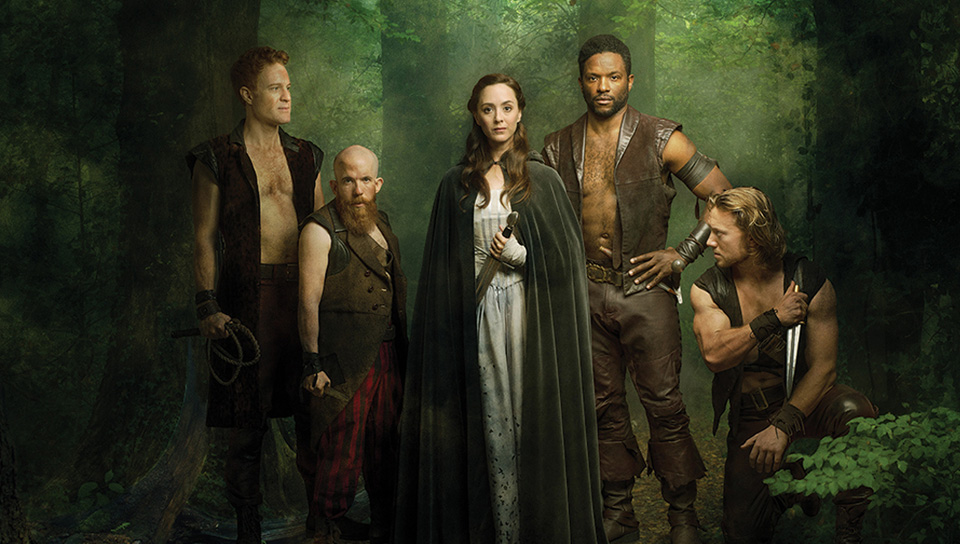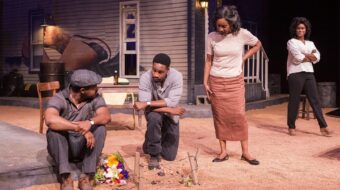
Beverly Hills, Calif.—What do you get when you cross Cirque du Soleil with Into the Woods? If you were playwright/screenwriter/stage director David Farr you would come up with a delightfully acrobatic, romantic, cheesecake-rich new musical telling of the classic Robin Hood morality tale.
The Heart of Robin Hood is now playing at the Wallis Annenberg Center for the Performing Arts here, in a production by The Wallis and Vesturport. This show premiered at the Royal Shakespeare Theatre, Stratford-upon-Avon, in 2011, and has since traveled to a number of other venues. From the show’s Facebook page and a casual Internet search, it’s not clear where the show is headed next. Maybe back to Sherwood Forest for a rest.
Robin Hood is of course the bandit we all love, the rural rebel who robs the rich to give to the poor. He is an archetype for similar characters in a number of world cultures, such as Jesse James in our Wild West, or the Mexicans Joaquín Murrieta and Jesús Malverde. It’s the folk tradition that invents a people’s justice in a world where all the cards are stacked in favor of the nobles and the rich.
In Farr’s conception, Robin and his not very merry coterie of cutthroats steal from the rich, but I kept wondering, if they’re liberating well-to-do travelers through the forest of their jewels and fancy clothes, do they just hoard these newly acquired possessions? They appear to be living off the land, almost like feral beings swinging from ropes and climbing up trees. But do they barter bracelets for bread, do they turn coin into corn?
Once bold and sassy Marion, daughter of the Duke of York, turns up in the forest, escaping from being pawned off into a hateful marriage with wicked Prince John, she is able to demonstrate, through the power of love, that she’s not only “one of the guys” but is capable of aligning the outlaws’ sympathies with all the oppressed people under the noble thumb. Although exactly how the proceeds of future banditry will now be redistributed is also left unstated.
One of the virtues of the play—it’s not quite a musical although there is a generous amount of incidental music; perhaps it’s more of a spectacle—is that the social issues are brought out clearly. The crux of John’s rule is that he’s instituted a new tax, a “contribution,” to pay for the defense of England from foreign enemies. It’s the time of the Crusades, so the Duke of York and other white European men are off in the Holy Land fighting the Moors, making one ask just who are the foreign enemies we’re talking about? But John is collecting these monies only to mount an armed revolt against his own brother King Richard.
Another issue is, of course, the sexism of the time, against which Marion strikes a mighty, if not a mortal blow. She gets to marry the man she loves, who in time accepts her as a man’s equal. Additionally, the role of the church is brought out forcefully as a bulwark of patriarchal tradition. Refreshingly, Robin and Marion solemnize their union not at the altar before a priest but back in their beloved forest where a sacred oak tree provides all the pagan sanctity they require. The formal oath of the bandit band is to be loyal to the order to the oak and obey no god or man. The show feels very au courant: foreign wars of choice, taxes, corruption of the church, and the subjugation of women.
The incidental music is lively and fresh in a Celtic folk-rock way, with five joyful musicians, including the smoky-voiced gamin chanteuse, composer and lyricist Salka Sól. They come across as genial buskers interpolating themselves into the action as needed, and receding into the background when their sound but not their presence is required.
Sól is Icelandic, as are the co-directors Gisli Örn Gardarsson and Selma Björnsdóttir. From their credits it seems Reykjavik is quite the cultural center: I’ll have to plan a return visit there during the theatre season!
The staging is enthralling, with inventive Sherwood forest décor, a charming mix of period and non-period costumes, entrances made down a steep, well-used carpeted slope, doors and balconies popping out of the hills, with 17 actors (some playing multiple roles) and five musicians tumbling all over the sets, clever lighting effects, and a stage floor that opens up a well into which two, three—oh, now I’ve lost count—characters either are pushed or jump.
Every time there’s the opportunity for a little slapstick, a somersault, some saucy repartée, a swing on the ropes or a sword fight, the advantage is not missed. It’s a busy, frenetic, energetic, Errol Flynn-worthy, visually appealing adventure.
Now, with all these stock characters and situations, is it believable theatre? Perhaps here’s where a hearty suspension of disbelief comes in handy. The story is so episodic, situational and physical that not much space is afforded to exploring motivations or feelings that probe beneath the epidermis to that titular heart under Robin’s much-exposed, muscled chest. It’s a great-looking, and disarming-sounding show rich with often lusty, sometimes plummy British accents, but do not expect to be moved by memorably affecting characterizations. The two stars, Luke Forbes as Robin Hood and Christina Bennett Lind as Marion, are both excellent and very attractive actors, Lind especially as she shuttles back and forth between her female persona and the male Martin role she adopts to fit in to the band. It’s the hyperactive script and production that overwhelm their chemistry.
A word needs to be said about, uh, representation. Little John, who early on is introduced to Robin’s band, is indeed most capably played by a little person, Jeremy Crawford, who also serves as fight captain and aerial captain of the show. There are several jocular references made to his height, as though anything is fair game for wit and frivolity. In an admirable incidence of “blind casting,” Robin Hood is a man of color and no allusion to that is made, as he eventually bonds with the white renegade noblewoman Marion. I understand of course that other actors may take on the role, and in this production Sam Meader, playing Robin’s sideman Will Scarlett, is understudy for the part. Scripts cannot be altered from night to night depending on the ethnicity of the actor appearing in that performance.
At the same time, the character of Pierre, a court lutenist and clown who willy-nilly gets induced into the gang as Peter, is a full-figured foppish figure whose gestures, voice, stance and behavior communicate the very image of a self-absorbed, privileged queen. This role is played (by Daniel Franzese) with an eye and ear for guffawing humor, although he does contribute positively to the well-being of the good characters. It seems that some folks are available targets for typecasting and jest, and others not. We can’t expect everything in theatre or in life to be politically correct, but I’m just saying.
The two young actors in the play, Gavin Lewis and Lily Rose Silver as brother and sister Jethro and Sarah Summers, each have their opportunity to show pluck and agency in furthering the story along.
The show runs about two hours with one intermission. The producers recommend it for “adults of all ages and brave children”; there are scenes involving fighting, knives and swords, a hanging or two, and that overly familiar well. A promotional video can be seen here.
The Heart of Robin Hood plays through Dec. 17th. For showtimes, tickets and further information, go to the Wallis website here or call (310) 746-4000. The Wallis Annenberg Center for the Performing Arts is located at 9390 N. Santa Monica Blvd., Beverly Hills 90210.

MOST POPULAR TODAY

High Court essentially bans demonstrations, freedom of assembly in Deep South

U.S. imperialism’s ‘ironclad’ support for Israel increases fascist danger at home

Zionist organizations leading campaign to stop ceasefire resolutions in D.C. area

UN warns that Israel is still blocking humanitarian aid to Gaza

Resource wars rage in eastern Congo, but U.S. capitalism only sees investment opportunity






Comments